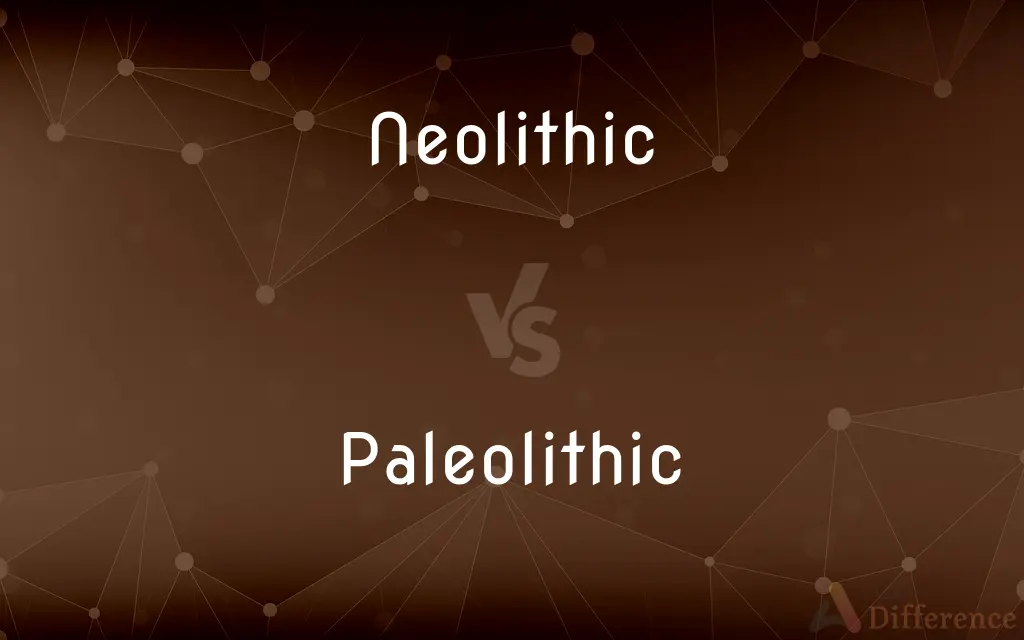Neolithic vs. Paleolithic — What's the Difference?
By Tayyaba Rehman — Updated on September 23, 2023
Neolithic is the "New Stone Age," marked by the advent of agriculture and settled communities. Paleolithic is the "Old Stone Age," characterized by hunter-gatherer lifestyles and the use of simple stone tools.

Difference Between Neolithic and Paleolithic
Table of Contents
ADVERTISEMENT
Key Differences
Neolithic, or the "New Stone Age," signifies the period when humans began practicing agriculture. Paleolithic, also known as the "Old Stone Age," represents a time when humans were hunter-gatherers.
The Neolithic era saw the development of settled communities and advanced stone tools. In contrast, the Paleolithic era is characterized by nomadic groups and simpler stone tools.
In Neolithic times, people began domesticating animals and constructing permanent structures. In Paleolithic times, people lived in temporary dwellings like caves or makeshift huts.
The Neolithic period typically includes the invention of pottery and weaving. Paleolithic art mostly consists of cave paintings and small portable sculptures.
Both periods are sub-divisions of the Stone Age, which is the earliest known period of human history. However, the Neolithic era represents a more advanced stage of human development compared to the Paleolithic era.
ADVERTISEMENT
Comparison Chart
Lifestyle
Settled, Agricultural
Nomadic, Hunter-Gatherer
Tools
Advanced Stone Tools
Simple Stone Tools
Structures
Permanent Buildings
Temporary Dwellings
Domestication
Animals and Plants
None
Art
Pottery, Weaving
Cave Paintings
Compare with Definitions
Neolithic
Neolithic is characterized by settled communities.
Neolithic villages had permanent structures.
Paleolithic
Paleolithic tools were relatively simple.
Paleolithic tools were often made of flint.
Neolithic
Neolithic includes advancements like pottery.
Pottery was invented in the Neolithic era.
Paleolithic
Paleolithic refers to the "Old Stone Age."
The Paleolithic era predates the use of agriculture.
Neolithic
Neolithic marks the beginning of agriculture.
Neolithic farmers grew grains and raised livestock.
Paleolithic
Paleolithic humans lived in temporary dwellings.
During the Paleolithic era, people lived in caves.
Neolithic
Neolithic refers to the "New Stone Age."
The Neolithic era brought advancements like agriculture.
Paleolithic
Paleolithic art primarily includes cave paintings.
The cave paintings at Lascaux date back to the Paleolithic era.
Neolithic
Neolithic people domesticated animals.
The Neolithic period saw the domestication of dogs and cattle.
Paleolithic
Paleolithic is characterized by a hunter-gatherer lifestyle.
Paleolithic people hunted and gathered their food.
Neolithic
The Neolithic period is the final division of the Stone Age, with a wide-ranging set of developments that appear to have arisen independently in several parts of the world. It is first seen about 12,000 years ago when the first developments of farming appeared in the Epipalaeolithic Near East, and later in other parts of the world.
Paleolithic
The Paleolithic or Palaeolithic or Palæolithic (), also called the Old Stone Age, is a period in human prehistory distinguished by the original development of stone tools that covers c. 99% of the period of human technological prehistory.
Neolithic
Of or relating to the cultural period of the Stone Age beginning around 8,000 BC in the Middle East and later elsewhere, characterized by the development of agriculture and the making of polished stone implements.
Paleolithic
Of or relating to the cultural period of the Stone Age beginning with the earliest chipped stone tools, about 2.4 million years ago, until the beginning of the Mesolithic Period, about 15,000 to 11,500 years ago in western Asia and southern Europe.
Neolithic
The Neolithic Period. Also called New Stone Age. See Usage Note at Three Age system.
Paleolithic
The Paleolithic Period. Also called Old Stone Age. See Usage Note at Three Age system.
Neolithic
(informal) hopelessly outdated
What am I supposed to do with this neolithic piece of machinery?
Paleolithic
Alternative case form of Paleolithic
Neolithic
Of or pertaining to, or designating, an era characterized by late remains in stone; the late stone age. Estimated as beginning around 9000 b. c. in the Middle East, this period is characterized by the beginnings of farming, the domestication of animals, and the manufacture of textiles and pottery.
The Neolithic era includes the latter half of the "Stone age;" the human relics which belong to it are associated with the remains of animals not yet extinct. The kitchen middens of Denmark, the lake dwellings of Switzerland, and the stockaded islands, or "crannogs," of the British Isles, belong to this era.
Paleolithic
(informal) Extremely outdated.
These laws are absolutely paleolithic.
Neolithic
Latest part of the Stone Age beginning about 10,000 BC in the middle east (but later elsewhere)
Paleolithic
Of or pertaining to an era marked by early stone implements. The Paleolithic era (as proposed by Lubbock) includes the earlier half of the "Stone Age;" the remains belonging to it are for the most part of extinct animals, with relics of human beings.
Neolithic
Of or relating to the most recent period of the Stone Age (following the mesolithic);
Evidence of neolithic settlements
Paleolithic
Second part of the Stone Age beginning about 750,00 to 500,000 years BC and lasting until the end of the last ice age about 8,500 years BC
Paleolithic
Of or relating to the second period of the Stone Age (following the eolithic);
Paleolithic artifacts
Common Curiosities
What does Paleolithic mean?
Paleolithic refers to the "Old Stone Age," characterized by hunter-gatherer lifestyles.
Did Neolithic people have permanent homes?
Yes, Neolithic communities often had permanent structures.
What types of tools were used in the Neolithic era?
The Neolithic era had more advanced stone tools.
What kind of art is associated with the Paleolithic era?
The Paleolithic era is famous for its cave paintings.
What animals were domesticated in the Neolithic era?
Animals like dogs, cattle, and sheep were domesticated during the Neolithic era.
When did the Paleolithic era start?
The Paleolithic era started around 2.5 million years ago.
What does Neolithic mean?
Neolithic refers to the "New Stone Age," characterized by agriculture and settled communities.
What types of tools were used in the Paleolithic era?
The Paleolithic era featured simpler stone tools.
What kind of art is associated with the Neolithic era?
The Neolithic era is known for pottery and weaving.
Did Paleolithic people practice agriculture?
No, Paleolithic people were hunter-gatherers.
Did Neolithic people practice agriculture?
Yes, agriculture is a defining feature of the Neolithic era.
Did Paleolithic people have permanent homes?
No, Paleolithic people usually lived in temporary dwellings like caves.
Are both Neolithic and Paleolithic part of the Stone Age?
Yes, both the Neolithic and Paleolithic eras are sub-divisions of the Stone Age.
Were any animals domesticated in the Paleolithic era?
No, animal domestication began in the Neolithic era.
When did the Neolithic era start?
The Neolithic era started around 10,000 BCE.
Share Your Discovery

Previous Comparison
Chemical vs. Bioreactor
Next Comparison
Emo vs. GothAuthor Spotlight
Written by
Tayyaba RehmanTayyaba Rehman is a distinguished writer, currently serving as a primary contributor to askdifference.com. As a researcher in semantics and etymology, Tayyaba's passion for the complexity of languages and their distinctions has found a perfect home on the platform. Tayyaba delves into the intricacies of language, distinguishing between commonly confused words and phrases, thereby providing clarity for readers worldwide.















































